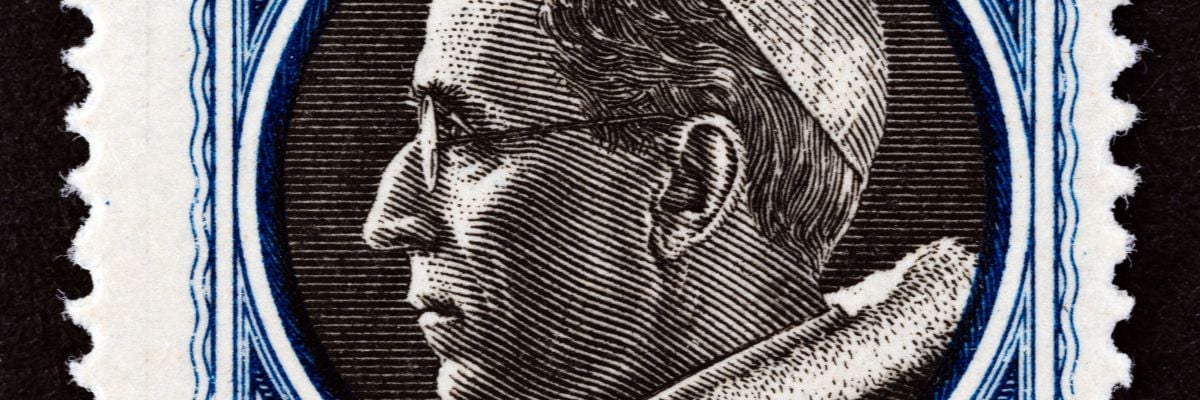
The publication of John Cornwell’s Hitler’s Pope in 1999 resurrected the dispute over Pope Pius XII, the Catholic Church, and the long and complex history of Catholic-Jewish relations. The book was justifiably condemned for its appalling research, biased interpretation of events, and anti-Catholic (and especially anti-papal) agenda. But what made it so additionally egregious was the mainstream media’s acceptance of Cornwell’s fallacious attack as gospel truth. As the Washington Post proclaimed:
The title tells the tale. And a chilling tale it is: Eugenio Pacelli, then the Vatican’s all-powerful secretary of state, made it possible for Adolf Hitler to achieve total power in Germany and, as Pope Pius XII, went on to appease him, maintaining inexplicable public silence as the Nazis destroyed and massacred millions of European Jews before and during World War II. . . . Had Pius XII publicly condemned Hitler’s acts—and even top Germany military commanders in Italy secretly urged him to do so toward the end of the war—many millions of lives might have been saved.
The slander perpetrated by Cornwell and a number of authors who followed him came as no surprise. The roots of the attack—made all the more grotesque by the claim of Cornwell to be a “practicing Catholic”—go back to Rolf Hochhuth’s 1963 play The Deputy. A leftist writer who merely parroted the anti-papal propaganda of the Soviet Union, Hochhuth found a willing audience in the West. The accusations against Pius XII, therefore, essentially originated in a scurrilous work of fiction written more than a decade after the war. Since then, the holy and beloved Pius XII has become the favorite target of anti-Catholics—and dissident Catholics who see him as the chief villain in modern Catholicism and the model for all that is wrong with the Catholic Church.
In the immediate wake of Hitler’s Pope, the task of defending Pius XII fell to a small but dedicated cadre of scholars and Catholic apologists such as Sr. Margherita Marchione, frequent This Rock author Ronald Rychlak, and the Catholic League for Religious and Civil Rights. After valiantly leading the fight to exonerate Pope Pius and provide a thorough critique of Cornwell’s book, these first defenders were joined by a host of other writers and apologists. In the end, while Cornwell and other anti-papal zealots did severe damage to the name and reputation of Pope Pius XII, they also created a backlash and helped galvanize a movement of apologists.
New Attack, Same Result
This background is crucial in appreciating the December 28, 2004, publication of a front-page story in the Italian newspaper Corriere della Sera entitled “Pius XII ordered: do not give back the Jewish children: The future Pope Roncalli disobeyed,” by Alberto Melloni, professor of contemporary history at the University of Modena and Reggio Emilia. The article was yet another effort to discredit Pius XII on the Holocaust/anti-Semitic charge and derail the pontiff’s beatification and canonization. This time, though, Catholic apologists, scholars, and journalists were ready to answer and debunk the slander with striking speed and accuracy.
The story was built around the leak of an unpublished document dated October 23, 1946, supposedly drafted by the Holy Office and approved by Pius XII and sent to Archbishop Angelo Roncalli (the future Pope John XXIII), then-nuncio to France, regarding Jewish children who found refuge in Catholic homes and institutions. Jewish officials were requesting their return. The note in question was unsigned, the author is unknown, and it was not on Vatican letterhead. Curiously, the text was not in Italian (as was customary for Vatican communications to its nuncios) but in French, making more apparent that it lacked any official status as a message from the Holy Office or Vatican Secretariat of State. The French text boasted seemingly explosive and horrendous instructions:
With regard to the Jewish children who, during the German occupation, have been entrusted to Catholic institutions and families and whom Jewish institutions are reclaiming to be entrusted to them, the Holy Congregation of the Holy Office has taken a decision that can be summarized as follows:
- Avoid, as much as possible, to answer in writing to Jewish authorities, but do it orally.
- Each time that it will be necessary to respond, it must be said that the Church must make its inquiries to study each case separately.
- The children who have been baptized could not be entrusted to institutions that would not be in a position to ensure their Christian education.
- For the children who have lost their relatives, given that the Church looked after them, it would not be appropriate that they would be abandoned by the Church or entrusted to persons who have no rights over them, at least until they are in a position to dispose of themselves. This, obviously, for the children who would not have been baptized.
- If the children were entrusted by relatives, and if the relatives reclaim them now, inasmuch as the children have not been baptized, they can be returned to them.
It is to be noted that this decision of the Holy Congregation of the Holy Office has been approved by the Holy Father.
The document was immediately seized upon by media and declared proof positive of the pontiff’s rampant anti-Semitism and indifference. On December 29, the Guardian newspaper in England added, “The letter deals a new and crushing blow to the reputation of the wartime pope, Pius XII.” On January 9, 2005, the New York Times presented its own article on the basis of the “discovery,” essentially repeating the charges made by Melloni, and placed on its web site an English version of the French letter under the title “1946 Letter from the Vatican.”
But within days of the original article in Corriere della Sera, the entire story was proved to be based on a dubious piece of evidence. Leading the charge were two of Italy’s leading experts on Pius XII, Andrea Tornielli and Matteo L. Napolitano, co-authors of Il Papa che salvo gli Ebrei (The Pope Who Saved the Jews). In a front-page article for the January 11 edition of Il Giornale, Tornielli published the original Vatican document and compared it to the French translation. In the same issue of Il Giornale, Napolitano castigated Melloni for his erroneous and misleading use of the memo.
The Case of the Missing Pages
As revealed by Tornielli, the controversial text proved to be only one page of a three-page document. The other two pages were attached in the archives but were never revealed by Melloni or the New York Times.
Page 2 is a typewritten memo from Msgr. Tardini of Holy Office to the Apostolic Nunciature in Paris entitled “The problem of Jewish children welcomed by Catholic charities during the war.” The letter is dated September 28, 1946, and it reads as follows:
The Most Eminent Fathers decided that if possible, there should be no response to the request of the Grand Rabbi of Jerusalem. In any event, if it is necessary to say something, it should be done orally, given the danger of abuse and distortion of anything written from the Holy See on the subject. Eventually, it will be necessary to explain that the Church must do its own research and observations in order to discern case by case, it being evident that children who were baptized cannot be entrusted to institutions that cannot guarantee their Christian education. Furthermore, also those children who were not baptized and who no longer have living relatives, having been entrusted to the Church who received them, as long as they are not able to decide for themselves, they cannot be abandoned by the Church or delivered to parties who have no right to them. It would be something else if the children were requested by their relatives. The decision of the Eminent Fathers and the criteria here presented were referred to the Holy Father in an audience of March 28, and His Holiness deigned to provide his august approval.
The third page is also a typewritten letter and bears the same reference number (4516) and date as page 2 and the notation of the Apostolic Nunciature of France. In French, it reads:
With regard to the Jewish children who, during the German occupation, have been entrusted to Catholic institutions and families and whom Jewish institutions are reclaiming to be entrusted to them, the Holy Congregation of the Holy Office has taken a decision that is here reported in its entirety.
It then repeats the memo on page 2 in Italian, and at the bottom is a note in French: “Excerpt of a letter of His Excellency Msgr. Tardini dated September 28, 1946 Prot. 6972/46.”
As the complete three-page document shows, Tardini sent a letter to Roncalli on September 28, 1946, regarding the Holy Office’s response to requests from Jewish Institutions (but not families) asking for the Jewish children. The memo makes clear that if Jewish children were reclaimed by family members, these children—whether baptized or not—were to be reunited with their Jewish families. (The original three-page document can be viewed at www.vaticanfiles.net/intelligence2.htm.)
Clearly missing in the Italian original is the most inflammatory point in the French text, namely, that unbaptized children cannot be returned to their families. In truth, Pope Pius had approved the decision that Jewish children were to be returned to their families regardless of their baptismal status. But that didn’t stop Melloni, who claimed to have discovered the poor French translation while suppressing the real documents on which it was loosely based. Pius XII, as Rychlak wrote on Beliefnet.com, “was being framed.”
Apologists to the Rescue
The refutation of the original attack came within days of the articles in Corriere and the Times. It began with the articles in Il Giornale on January 11 and continued over the succeeding weeks. Rychlak wrote his article for Beliefnet.com, and Inside the Vatican, in its January-February 2005 issue, reprinted Rychlak’s original article and added “Another Anti-Papal Hoax” by William Doino. Fr. Peter Gumpel, S.J., the relator for the cause of Pope Pius XII, gave many interviews on the errors in Melloni’s article and the continuing progress of the cause.
Equally helpful were the efforts by media critics in condemning the mainstream media’s shabby tactics. On April 16, 2005, Accuracy In Media released Sherrie Gossett’s article ” New York Times Publicizes Phony Memo from the Pope’s Pope,” which castigated the newspaper for its poor research and asked, “Are New York Times staffers now under the impression the Vatican is in Paris? Or perhaps they think Rome is in Paris?” Newsmax.com, a conservative news outlet, also detailed the egregious episode.
But even after the complete refutation of the lies in the Melloni and Times articles, the war against the Pope (and the papacy) continued. National Public Radio gave a platform to Melloni to repeat his false charges on its All Things Considered (January 21, 2005) but failed to mention the articles in Il Giornale or present an opposing opinion. The New Republic, in its January 31 edition, permitted anti-papal polemicist Daniel Goldhagen to repeat his wild claims of a Catholic conspiracy to kidnap Jewish children.
Still, the rapidity of the exposure of the original articles’ distortions is evidence that the truth is being heard. Credit goes to scholars such as Rychlak, Gumpel, and others, but the episode also points to the long road ahead for historical Catholic apologetics. The task now is to develop even more effective means of Catholic social communications to respond immediately to the attacks and be proactive in making broadly known the truth of Pope Pius XII’s record and the heroic deeds of the Church during World War II to save tens of thousands of Jews from the Nazis.



